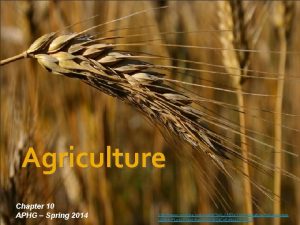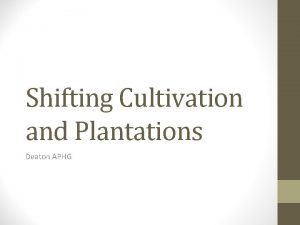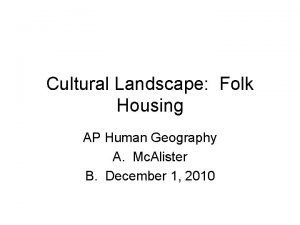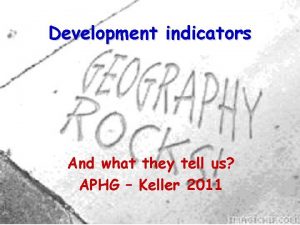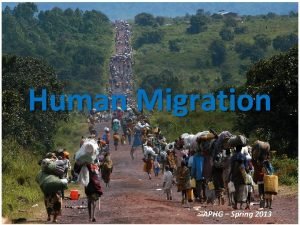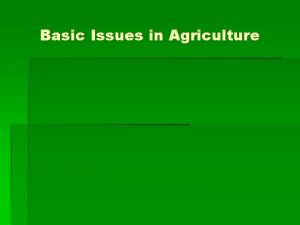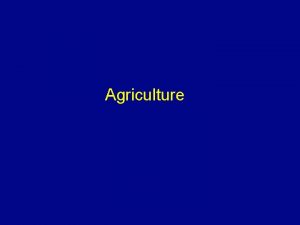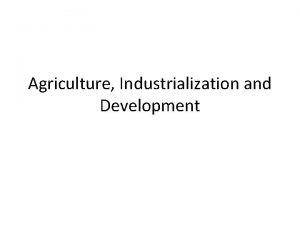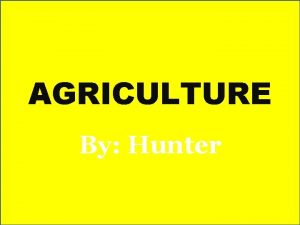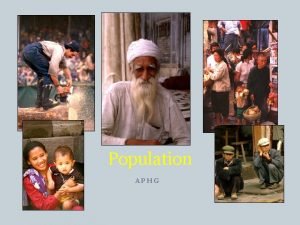Agriculture Chapter 15 APHG Spring 2018 http www






















- Slides: 22

Agriculture Chapter 15 APHG – Spring 2018 http: //www. youtube. com/watch? v=LX 153 e. Yc. Vr. Y&feature=c 4 -overviewvl&list=PLpni. JUe. AKfup. MAob. WOt. Cv. Emjos. Zi. PX 07 S

Key Issues • Where Did Agriculture Originate? • Why Do People Consume Different Foods? • Where is Agriculture Distributed? • Why Do Farmers Face Sustainability Challenges?

Agriculture • A deliberate modification of Earth’s surface through cultivation of plants and rearing of animals to obtain sustenance or economic gain. • Cultivate = “to care for” • Crop = any plant cultivated “by people” • Intertillage – Planting many crops per plot of land. 1. Less than 2% of Americans are farmers 2. Agriculture production is at a all time high 3. Culture dictates how land is divided and for what purpose 1. Islam and Judaism avoid pork 2. Hindus do not eat beef, etc.

Economic Sectors Primary employment sector. This sector consists of jobs in which people extract resources from the environment. Ex. Farming, mining, fishing, and forestry. Secondary employment sector – Jobs in which people take resources and make them into something else are classified under the secondary employment sector. Ex. Manufacturing, processing, or construction jobs Tertiary employment sector – Jobs classed in this sector are those in which people provide services. Ex. Lawyers, teachers, doctor

Hunters and Gathers Before the invention of agriculture, all humans probably obtained the food they needed for survival though hunting of animals, fishing, or gathering. 1. Lived in small groups 2. Traveled frequently 3. Establishing new homes or camps 4. Direction of migration depended on movement of game and seasonal growth of plants. 5. Only about 250, 000 people throughout the world 1. San in Southern Africa https: //www. youtube. com/watch? v=826 HMLoi. E_o 2. Aboriginal people in Australia 3. Hunters and gathers of the Amazon http: //www. youtube. com/watch? v=AC 89 u. UMVVts&feature=related

#paleoproblems

Types of Cultivation Vegetative planting – direct cloning from existing plants, such as cutting stems and dividing roots. Plants found growing wild were deliberately divided and transplanted. Seed agriculture – reproduction of plants through annual planting of seeds that results from sexual fertilization. Seed agriculture is practiced by most farmers today.

Vegetative Planting Hearths There were several main hearths, or centers of origin, for vegetative crops (roots and tubers, etc. ), from which the crops diffused to other areas.

Seed Agriculture Hearths Seed agriculture also originated in several hearths and diffused from those elsewhere.

Crop Hearths

Animal Hearths

First Agriculture Revolution 10, 000 – 12, 000 years ago, closely aligned with the declining Ice Age, accompanied by a modest population explosion. Hearths or regions of plant domestication and specific products 1. Upper SE Asia – rice, bananas, beans, teas 2. Lower SE Asia – sugarcane, ginger, citrus 3. Eastern India – rice, sorghum, ginger 4. SW Asia – wheat, barley, rye, beets, grapes 5. East Africa – melons, gourds, coffee 6. Mesoamerica – corn, squash, chili peppers, avocado 7. Mediterranean Basin – grapes, olives, dates, lettuce, carrots 8. Central China – radishes, peaches 9. Sudan – sorghum, millets, yams, peas 10. Andean Highlands – potato, pumpkin, tomatoes, strawberry, papaya 11. Eastern South America – peanuts, pineapples, cotton, tobacco

Categories of Agriculture Subsistence – growing only enough to survive. Most common in LDC’s 1. Shifting Cultivation (also know as slash and burn) a. Clear the land b. burn foliage for fertilizer c. Moving to the next field when yields go down Commercial farming – production of food for sale. Most common in MDCs. a. commercial agriculture is less efficient. Why? b. in order for commercial agriculture to be a success, it must be supported through the use of subsidies. c. Commercial agriculture is dependent on inanimate energy. d. Commercial agriculture is generally a monoculture system. e. Commercial farming lends itself to agribusiness – large food production industry. Ex, Tyson, Conagra, etc. http: //www. themeatrix. com/? video=g. F 86 kagea. EM

Agriculture and Climate

World Agriculture Regions Locations of the major types of subsistence and commercial agriculture.

Commercial and Subsistence Agriculture • Five characteristics distinguish commercial from subsistence agriculture. • • • Purpose of farming Percentage of farmers in the labor force Use of machinery Farm size Relationship of farming to other businesses

Labor Force in Agriculture A large proportion of workers in most LDCs are in agriculture, while only a small percentage of workers in MDCs are engaged in agriculture.

Area of Farmland Per Tractor Use of machinery is extensive in most MDC agriculture, but it is much less common in LDCs.

Shifting Cultivation 1. Practiced in much of the world’s low-latitude. A-type climate regions. 2. Two Features: - land is cleared by slashing and burning debris - land is tended for only a few years at a time. 3. Traditionally, land is not owned individually 4. Types of crops grown vary regionally. 5. Shifting cultivation is being replaced by logging, cattle ranching, and cash crops. Shifting cultivation – positive or negative?

Shifting Cultivation Shifting cultivation by the Trio tribe in the rainforest of Southern Suriname

Pastoral Nomadism 1. Form of subsistence agriculture based on the herding of domesticated animals. 2. Found primarily in arid and semiarid B-type climates 3. Animals are seldom eaten -The size of the heard indicates power and prestige 4. Number and type of animals are selected according to local cultural and physical characteristics. -For example, camels are favored in North Africa and SW Asia 5. Transhumance practiced by some pastoral nomads 6. Declining because of technology

Pastoral Nomadism Pastoral nomads camping near Namtso in 2005 Source: Sidahmed and Koong (1984)
 Intensive subsistence agriculture aphg
Intensive subsistence agriculture aphg Bae yong-kyun
Bae yong-kyun Spring summer fall winter
Spring summer fall winter Que letra continua m v t m j
Que letra continua m v t m j Township and range ap human geography
Township and range ap human geography Suburbanization definition aphg
Suburbanization definition aphg Shifting cultivation aphg
Shifting cultivation aphg Map types ap human geography
Map types ap human geography Least cost theory
Least cost theory Affordable housing ap human geography
Affordable housing ap human geography Sex ratio ap human geography definition
Sex ratio ap human geography definition Remote sensing ap human geo
Remote sensing ap human geo Proportional symbol map ap human geography
Proportional symbol map ap human geography Sex ratio aphg
Sex ratio aphg Devolution aphg
Devolution aphg Bid rent theory example
Bid rent theory example Nation-state ap human geography
Nation-state ap human geography Harris and ullman multiple nuclei model example
Harris and ullman multiple nuclei model example Structuralist theory aphg
Structuralist theory aphg Nucleated settlement ap human geography
Nucleated settlement ap human geography Http //mbs.meb.gov.tr/ http //www.alantercihleri.com
Http //mbs.meb.gov.tr/ http //www.alantercihleri.com Http //pelatihan tik.ung.ac.id
Http //pelatihan tik.ung.ac.id Blue spring from a distance chapter 1
Blue spring from a distance chapter 1
